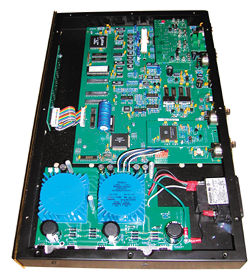| Columns Retired Columns & Blogs |
Lavry Engineering DA2002 D/A processor Page 2
As I write these words, I am about to drive to Goshen College in Indiana to record my fourth CD for Cantus, the unaccompanied male choir from Minnesota. One thing I have learned from my previous three recordings of the group is that when singers let it all hang out, lesser CD players and digital processors lend the mid-treble a shouty quality, almost a "rattle." Some of this is real—I hear it when I'm in the hall with the singers. But with the Lavry fed by a Mark Levinson No.31.5 transport, my 2003 Deep River CD (Cantus CTS1203) sounded as sweet in this respect as Cantus had live. Perhaps more important, each of the 11 singers could be clearly heard to occupy his own place in the soundstage. Nice, very nice.
 Comparisons
Comparisons
All comparisons were performed with the levels matched to within 0.1dB at 1kHz. First up was my longtime reference, the Levinson No.30.6, which cost $17,500 when last available. Playing Soular Energy again, the Lavry DA2002 didn't have the low-bass reach or ultimate authority of the No.30.6, but Ray Brown's bass was presented both a bit more forward in the soundstage and with a slightly more palpable sense of "being there." The Levinson's image was flatter, with less depth and less lower-midrange bloom. Again, I'm forced to use the simile "tubelike" to describe the DA2002's character, which I preferred.
In the higher frequencies, I was hard-pressed to tell the two processors apart. Carol Wincenc's flute on my Mozart Flute Quartet CD (Serenade, Stereophile STPH009-2) sounded equally sweet through both, with the slight chiff of her breath on the notes' leading edges neither exaggerated nor mellowed. Even on raucous modern rock mixes, such as our June 2002 "Recording of the Month," Wilco's Yankee Hotel Foxtrot (CD, Nonesuch 79669-2), it was hard to tell the two processors apart, other than by the differences in bass and soundstage presentation mentioned earlier.
Next on deck was the sample of the Benchmark DAC 1 that I'd purchased after reviewing it in the May Stereophile (p.117). Like the Lavry, the Benchmark emanates from the pro-audio world, and offers superb sound quality and superb value at its $975 price. Playing the Mozart Flute Quartet again, the Benchmark and Lavry DACs were very close in tonal character. Perhaps the breath-noise chiff was a little more forward in the soundstage with the Benchmark, the treble balance a little harder.
In the low frequencies, there was basically no difference that I could detect between the Lavry and the Benchmark. However, the two processors became a little easier to distinguish with my Deep River CD. As I had found with the Levinson comparisons, the Lavry's lower midrange had more bloom compared with the Benchmark. There was a slightly better sense of "being there," in that the unaccompanied men's voices were more solidly positioned in the hall acoustic.
The bloom wasn't always a benefit. When I mixed Stereophile's Rendezvous CD (STPH013-2), I ended up balancing Jerome Harris' Taylor acoustic bass guitar a little lower in level than he or I were anticipating. Musically this made sense, but the instrument's image is a little fragile as a result. The Lavry's bloom robbed the bass guitar of some of its leading-edge energy compared with the Benchmark. Not unpleasant, and not something I perhaps would notice except in A/B comparisons, but I suspect that if I'd used the DA2002 when mixing the album, I would have raised the bass guitar level slightly.
My final comparison was with the $12,000 Nagra DAC that Kalman Rubinson reviewed in May (p.85). Dr. Kal had enthused over the Swiss DAC's clarity and powerful dynamics; when I plugged the Nagra into my system and hooked up the Levinson CD transport to its AES/EBU input with a DH Labs Silver Sonic datalink, I could immediately hear why it had impressed him.
But that doesn't mean it outclassed the Lavry DA2002. Yet again, I had to sweat to perceive any meaningful differences at all between the two DACs. It was my Mosaic CD (Stereophile STPH015-2) where I thought I had it down: in the slow movement of the Brahms Clarinet Quintet, soloist Antony Michaelson barely breathes the notes. The Nagra was ever so slightly better at defining the space around the image of the clarinet, as each note slid into the next. But in other respects—Ray Brown's bass on the 96kHz Soular Energy, the voices on Deep River—it was a wash.
Problems
I had two minor problems during my time with the DA2002. The first was probably a design flaw: It didn't mute when fed a Dolby Digital bitstream. This was a disadvantage when playing DVD-Video discs, which may have high-quality LPCM tracks for the music but sometimes use a Dolby track for the menus. The result was a disturbing blast of pulsed white noise as I groped for the Mute button on the preamp's remote.
The second problem was that, very occasionally, the DAC would start to overlay zingy-sounding spuriae on the music, as though it were losing lock with the incoming datastream. (The input and sample-rate LEDs remained resolutely lit.) Rescanning the inputs so that the Lavry rediscovered the active one solved the problem, but the fact that it happened at all raised my eyebrows.
Summing up
Impressively engineered and even more impressive-sounding, Lavry Engineering's DA2002 is one of the few digital processors that I could live with in the long term. Yes, its inability to gracefully handle Dolby Digital bitstreams and its lack of de-emphasis should be addressed, and a version with a volume control would cause my audiophile cup to run over. A TosLink input would also maximize its usefulness. But, as it stands, I recommend the Lavry DA2002 very highly. It's definitely a high-end contender, at a relatively affordable price, from an unexpected source.
- Log in or register to post comments




































